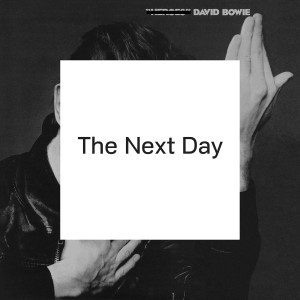 Francis Whately’s David Bowie: The Last Five Years will have its US premiere this week at DOC NYC. In addition to interviews with Bowie, Whately mixes in archival footage and audio from the recording sessions for Bowie’s final albums The Next Day and Blackstar. Alongside interviews with Bowie’s artistic collaborators and longtime band members, the backing tracks from both albums are performed live.
Francis Whately’s David Bowie: The Last Five Years will have its US premiere this week at DOC NYC. In addition to interviews with Bowie, Whately mixes in archival footage and audio from the recording sessions for Bowie’s final albums The Next Day and Blackstar. Alongside interviews with Bowie’s artistic collaborators and longtime band members, the backing tracks from both albums are performed live.
Whately situates Bowie’s final career renaissance in the context of an earlier 2003/2004 tour dubbed “A Reality.” His first major worldwide tour since 1995, Bowie was to reach over a million fans across twenty-four countries, the set list a retrospective of career-defining hits mixed with a smaller number of songs from his most recent album releases.
At the start of the tour, which had been heavily promoted, Bowie appeared in great physical shape and in excellent spirits, but his stamina was pushed to the limit by grueling two-and-a-half-hour long sets.
While performing in Germany, he became ill on stage, and was rushed by ambulance to a hospital. A few days later, the band was told that he’d suffered a heart attack. The tour was curtailed, and Bowie returned to New York where he took an indefinite hiatus.
This wasn’t the first time Bowie bid farewell to public life. In 1973, he abruptly “retired” after a triumphant sold-out concert at London’s Hammersmith Odeon Theatre. Having shed his Ziggy Stardust alter ego, he came back the following year as Halloween Jack, released the glam-trash album Diamond Dogs, and embarked on an ambitious and heavily hyped theatrical tour.
Then, in 1975, Bowie announced once again, “I’ve rocked my roll. It’s a boring dead end. There will be no more rock ‘n’ roll records or tours from me. The last thing I want to be is some useless f***ing rock singer.” But that declaration just meant that he had moved on again, this time to “plastic soul.”
He’d soon abandon that persona too, moving to Berlin, cleaning up, and releasing three albums many consider to his greatest: Low (1977), Heroes (1977) and Lodger (1979).
Bowie’s ability to reinvent himself over and over again was key to his genius and longevity. But 2004 was different, a lede that’s all but buried by Whately—perhaps because the BBC commissioned The Last Five Years after Bowie’s death as a sequel to Whatley’s 2013 film Five Years, which focused on five non-consecutive breakthrough years in Bowie’s early career.
The connection between the two films provides an interesting but forced conceit. Whately wants to draw a direct line from retirement to renaissance, but I think it’s important to understand Bowie’s final creative peak in the context of another less discussed retirement, one more presumed than official.
I’m referring to the years just before “A Reality.” Listen back to those albums from the early aughts. Bowie wasn’t suffering from youthful restlessness or ennui. 2000’s Hours, which was widely panned by critics, is saturated with midlife anxiety about aging and losing relevance. “Throw me tomorrow,” Bowie sings. “Not that I’ve really got a chance.” Sheesh.
For his next two albums, Bowie reunited with his old bandmates and the producer Tony Visconti, who’d been at the helm on his early masterpieces. The musicianship is incredibly strong, and critics hailed both albums as comebacks. But you’re still getting Bowie in the half-light.
On Heathen (2002), he sings, “Some of us will always stay behind/Down in space it’s always 1982/The joke we always knew.” And on the more upbeat rocker Reality (2003) it’s still, “Hey, now my sight is failing in this twilight/Da da da da da da da da da/Now my death is more than just a sad song.”
Going into the “A Reality” tour Bowie must have known full well what was at stake—not a simple victory lap around the globe, but proof positive that he still had the juice. The fact that the tour had to be cut short by an unexpected life-threatening heart attack must have shaken him, or at least led him to reevaluate his life under the weight of expectation.
It’s no wonder that his next comeback, his finest, was carried out in strict secrecy nearly a decade later. This time around, longtime members of his band were bound by non-disclosure agreements. Up until just before the album release there were no announcements, teaser tracks, or interviews.
The cover for The Next Day was an intentional defacing of Heroes—asking the listener to judge the work on its on own merits rather than against his past creative accomplishments. The strategy put him back on his game, yielding two hits, “Where Are We Now?” and “The Stars (Are Out Tonight).”
Bowie applied the same secrecy when it came to his next album, Blackstar, and his musical play, Lazarus, both made when he knew that he had cancer and his prognosis was not good—which he also kept quiet. He’d found perhaps the most effective mask of all, but not one he could hold onto forever.
In Whately’s film Bowie is said to have been reluctant to include the song “Heroes” in Lazarus until he heard a new arrangement that had transformed it from triumph to melancholy. As I watched this version being performed, I couldn’t help but think about what it must have meant to Bowie to see this on opening night, determined to be present and to be in the present.
And as I think about that melancholy triumph, I keep replaying another scene, from the end of Whately’s film, where Visconti remembers watching Bowie through a small window at the Magic Shop where he recorded the vocals for the song “Lazarus.” Visconti isolates the vocal track and plays it back so we can hear it, too.
https://www.youtube.com/watch?v=JDBfTc91kP8&w=550
“Look up here,” Bowie sings, “I’m in heaven.” Visconti recalls hearing Bowie reach so deeply within himself to sing those lines that each breath was audible. As Bowie appears in the video for “Lazarus,” which Whately superimposes over the studio window, Visconti suggests admirably, if not entirely convincingly, that these were not the last gasps of a dying man. He says they are those of a man in his full, summoning all of his strength and passion, restoring himself for a final comeback.
Visconti listens to the tape, remarking that Bowie was at “the top of his game,” but his expression reveals more. Bowie is gone now. The Magic Shop, too. It’s all gone—New York City, too, in a way. I saw this film at a press screening last week, and I wasn’t the only one crying as the screen faded to black.
I’d say leaving the theater was like walking out of a matinee, but it was in fact walking out of a matinee, not from darkness into light but into another kind of darkness. I walked down the stairs into the subway and waited for the F train, the “forever” train as it’s known here in New York, and the irony wasn’t lost on me.
***
David Bowie: The Last Five Years was originally broadcast on BBC Two on what would have been Bowie’s seventieth birthday. It will screen this Friday at DOC NYC and air on HBO at a later date TBA.
***
Feature image sourced via Creative Commons.




